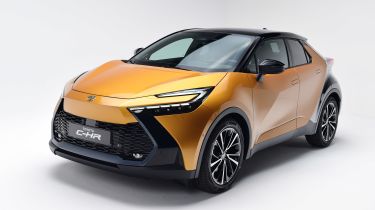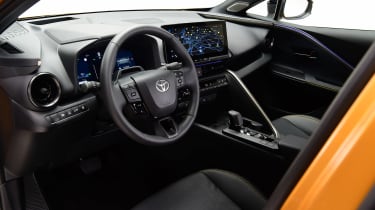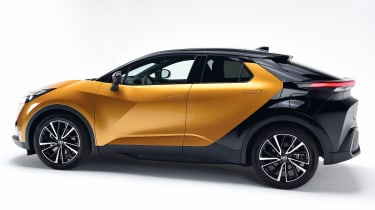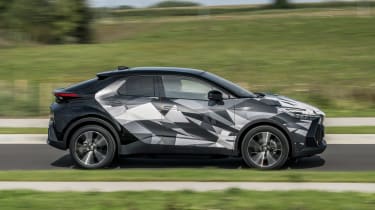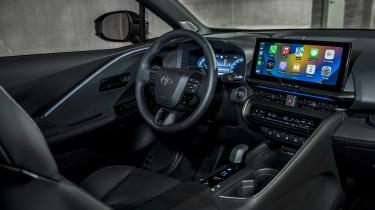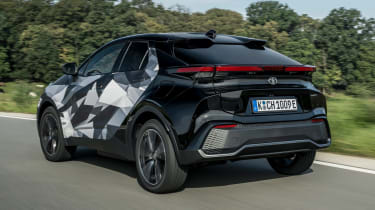New Toyota C-HR: details, specs and prototype review
Upcoming 2023 Toyota C-HR gets a choice of four hybrid powertrains – including a new PHEV which we’ve already tested in pre-production guise
- More spacious interior than outgoing C-HR
- Self-charging and plug-in hybrid powertrains
- First deliveries due later in 2023
This is the new Toyota C-HR: a Renault Arkana-rivalling crossover that will be available exclusively with hybrid power when it goes on sale later this year. We’ve now driven the upcoming C-HR prototype ahead of its full release later this year, so scroll down for our first impressions from behind the wheel.
The C-HR has been one of Toyota’s most popular models in the UK in recent years, so its replacement is big news. Its design sticks very closely to the C-HR prologue concept revealed in 2022 – complete with its distinctive front end and a full-width rear light bar.
In fact, visually, there is very little to distinguish the production model from its concept car forbear – both feature sharp C-shaped headlights and daytime running lights, a blanked-off upper grille, and sharp creases down the side. The wheels have a more conventional design and the rear doors get proper door handles to aid practicality.
 Top 10 best hybrid SUVs in 2025
Top 10 best hybrid SUVs in 2025
The steeply-raked rear window remains, though the intricate lighting signature that previously ran up the C-pillar has been simplified. The aforementioned full-width lightbar is only broken in the middle by an illuminated badge, which shows the car’s name at night. The production-ready lower bumper has lost its diffuser-style detailing, replaced by a honeycomb pattern and two small reflectors.
2023 Toyota C-HR interior
Inside, the new C-HR ushers in a completely new interior design for Toyota. There’s a wraparound dashboard that flows into the doors, while a central touchscreen (eight or 12.3 inches depending on spec) with Apple CarPlay and Android Auto sits above a row of independent climate controls. There’s a 12.3-inch digital instrument cluster, as well as recycled and animal-free materials dotted around the cabin.
It’s set to be a more practical car than its predecessor, with more space inside for passengers. We sat in a car at the launch event and while it’s still not as accommodating as conventional SUV rivals like the Nissan Qashqai or Skoda Karoq, it did feel roomier than what went before. Toyota hasn’t revealed boot space figures, but claims this is improved too.
The new C-HR has been “designed, engineered, and built in Europe, for European customers” according to Toyota. The previous model was hugely successful over here and brand bosses say it “helped transform public perception of Toyota in Europe”.
Engines, range and charging
However, while it feels as if every new car launched in the UK these days is electric, Toyota is sticking with tried and tested hybrid powertrains – offering not one, but four petrol-electric options for the latest C-HR. Joining a pair of conventional ‘self-charging’ hybrids will be a plug-in hybrid (PHEV) for the first time – available with or without all-wheel drive.
The entry-level car will feature the 138bhp 1.8-litre petrol-electric hybrid system from the Toyota Corolla. Above this sits a more powerful 193bhp 2.0-litre setup, which the maker says is an “even stronger proposition” thanks to its higher output “contributing to a rewarding hybrid driving experience with uncompromised efficiency”. The two cars will get from 0-62mph in 9.9 and 8.1 seconds respectively.
The plug-in hybrid model also uses a 2.0-litre petrol engine and electric motor, producing a combined 220bhp for a faster 0-62mph time of 7.4 seconds. In addition, there’s a 13.8kWh battery, which Toyota says is capable of 41 miles of pure-electric running. This results in combined efficiency of 313mpg, plus CO2 emissions as low as 43g/km.
Toyota says the C-HR PHEV gets a “one-pedal-like driving experience” with multiple modes for the regenerative braking system. When plugged in, the battery can be charged via a home wallbox in two-and-a-half hours.
The manufacturer says all versions get the latest “Toyota Safety Sense portfolio of active safety and driver assistance features” including Acceleration Suppression, which “slows any sudden use of the throttle” when “risk of a collision with a vehicle ahead is detected”.
Full prices and specs are yet to be confirmed, though these images do suggest a ‘GR Sport’ trim level will be offered. Toyota has already released details of a C-HR Premiere Edition, however, which showcases “the highest levels of equipment and styling.” These versions get two-tone paint, perforated leather seats, a head-up display and a panoramic roof. Over-the-air updates will be possible on all versions.
Toyota C-HR prototype review – Sean Carson
We’ve already had a chance to drive a plug-in hybrid prototype version of the Toyota C-HR ahead of its full reveal. Even when decked out in camouflage, the new C-HR’s styling appears much sleeker in the metal – it’s simpler and more handsome than before.
Stepping into the new C-HR, the interior felt of good quality, and makes use of more sustainable materials, such as seat fabric made from recycled plastic bottles. The interior also feels more spacious than before, especially in the back. There’s more legroom for passengers and our car’s panoramic roof meant there was plenty of headroom. The panoramic roof also gets a special coating to insulate the car from heat, rather than a traditional sun shade.
The driving position is a little strange, though, as despite the C-HR’s big-car stance, you sit rather low. This combined with the small rear windows means visibility is a weak point for both the driver when changing lanes, and rear passengers who might want to enjoy the view out.
Our pre-production car came with the 12.3-inch digital dash and 12.3-inch touchscreen running Toyota’s latest infotainment software. There’s a neat feature that allows the C-HR to save energy from the 13.8kWh battery for driving around low emissions zones. Geofencing technology means the car knows when it’s entering one of these areas and switches to electric power automatically. Apple CarPlay and Android Auto compatibility is included, but unfortunately cannot yet take data from the aforementioned predictive efficiency feature.
Setting off, we noticed how quiet and refined the new C-HR felt – our test model was a higher spec car fitted with acoustic glass for sound deadening, and of course the hybrid system meant that there was no engine noise until you started to accelerate hard. When it does kick in, the 2.0-litre four-cylinder engine can drone a little, but it’s not bad overall.
The ride was comfortable on the wavy test roads we took the car out on. The plug-in hybrid C-HR is fitted with frequency dependent suspension dampers, too, which do a good job offering support and control when you push the car harder through the corners, too. That means the C-HR is good at ironing out smaller bumps in the road, while staying composed over larger imperfections and potholes, or during more spirited driving.
That said, the 220bhp petrol-electric powertrain propels the C-HR from 0-62mph in 7.3 seconds – healthy numbers, but it doesn’t feel particularly fast. It’s not a car built for the enthusiastic driver, and is instead better suited to driving around town and under less aggressive acceleration.
It gets a regenerative braking system that offers three different levels and works well in its highest setting, though there’s no one-pedal driving mode. Toyota claims an official electric range of 41 miles, and on our short drive we managed to cover more than 35 miles.
Toyota C-HR prototype verdict:
The new Toyota C-HR appears to be coming along nicely judging by our experience of the latest prototype, and should be a strong contender in the family SUV class. Its competitive electric range, satisfactory performance, strong refinement and comfort are all plus points, and yet despite the latter the C-HR still feels composed and controlled to drive. Its improved practicality and tech over the outgoing model should also put it in a much better position than before, so long as the price is right.
The Toyota C-HR’s success will largely depend on its cost in this highly competitive class. We’d expect a price tag of less than £40,000 for the plug-in hybrid model when it goes on sale this winter, with the self-charging hybrid version costing less.
Need a new small family car sooner rather than later? Check out our list of the top 10 best small SUVs
Recommended
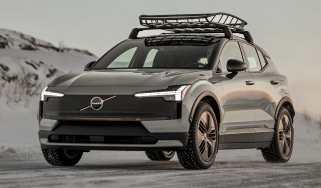
Rugged Volvo EX30 Cross Country arrives with £47k price tag

New Land Rover Defender Sport spotted and it’s an electric baby SUV
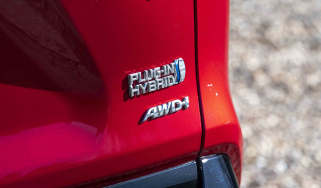
Petrol and diesel car ban relaxed with hybrids permitted beyond 2030

Sharper design and tech for Renault Austral hybrid SUV
Most Popular
Tips & advice

Car dashboard warning lights: what does each symbol mean?

Electric car charging stations: public networks, charger types, apps and maps


